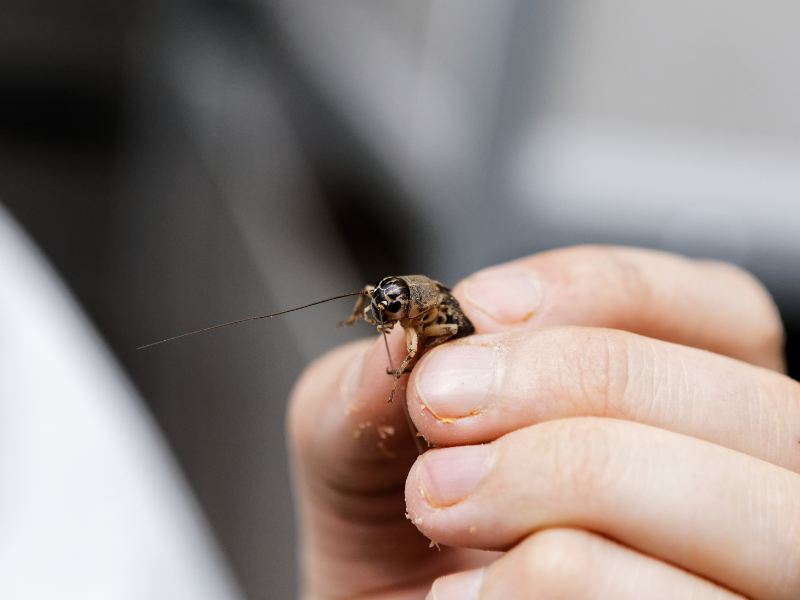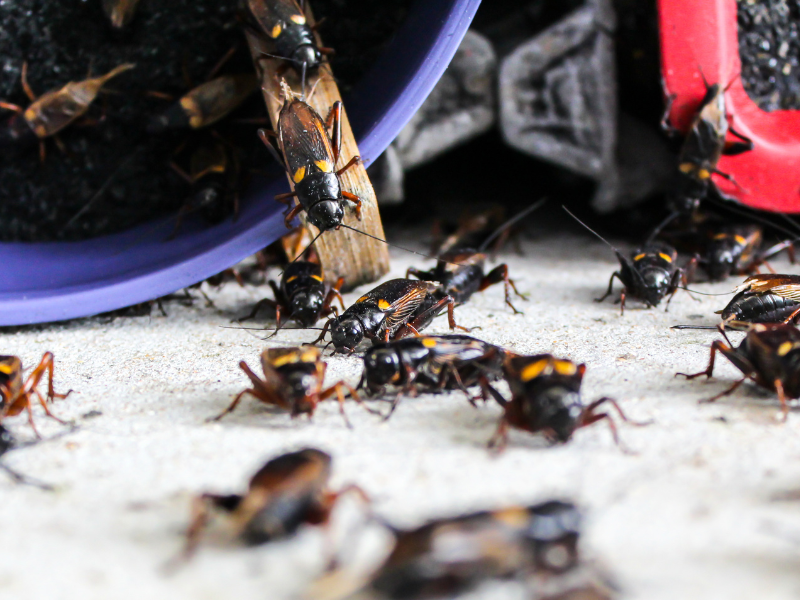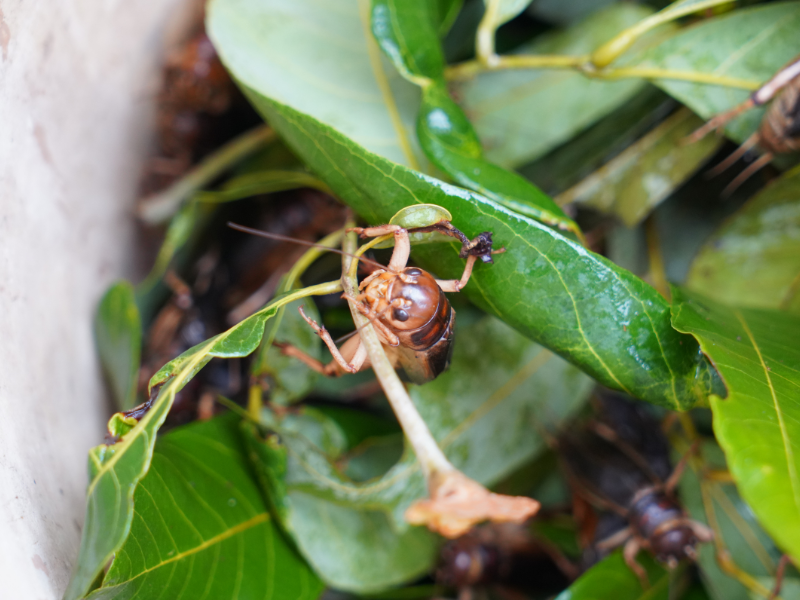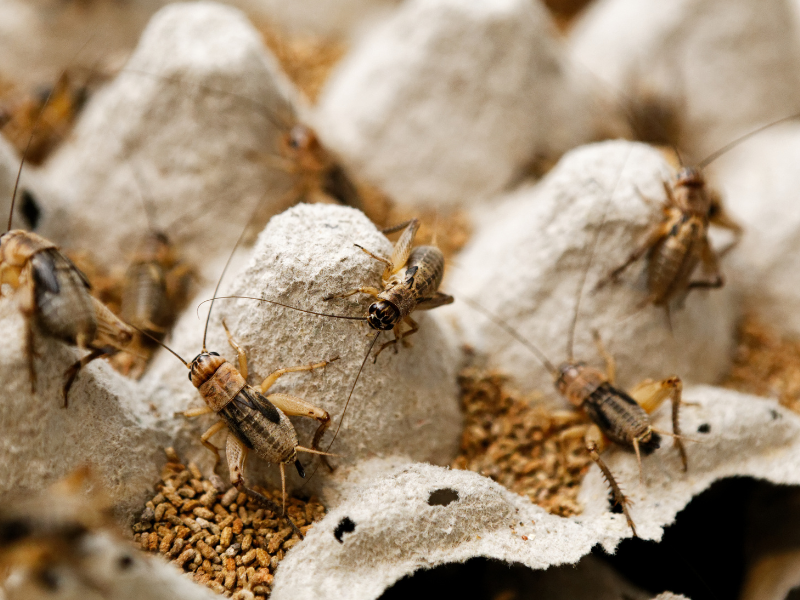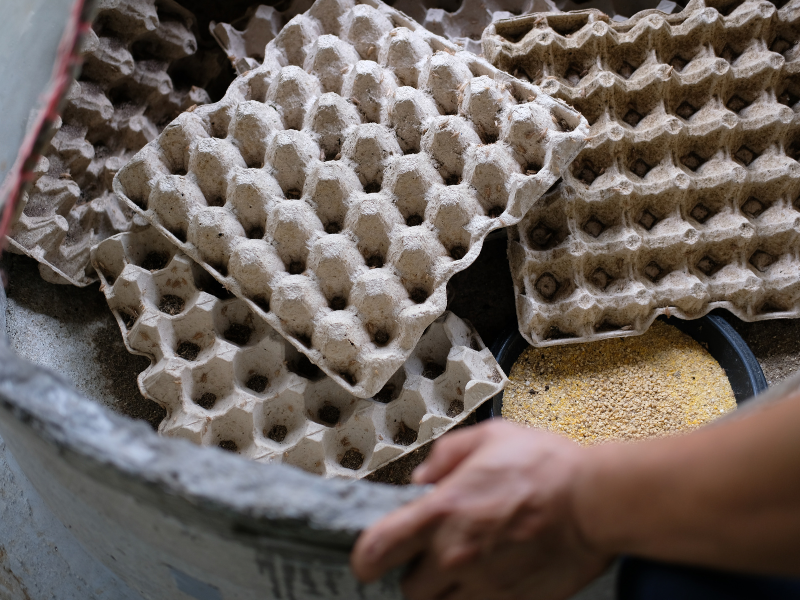Cricket farming is already a thriving business in Asia, Africa, and South and Central America. In those areas of the world, people raising crickets are earning an average $5-10,000 net. And that’s in areas where the average gross income is under $6,000.
People and businesses have been breeding crickets as food for chickens, reptiles and fish for 70 years. Right now, the insect farming market is growing by more than 20% annually.
The insect farming business is shifting to expanding its niche in the human food markets. They are packed with protein for their size.
According to the North American Coalition for Insect Agriculture (NACIA), crickets as human food are high protein and can be prepared by cooking or by being ground into flour. The flour becomes a high protein ingredient in various food such as tortilla chips and protein bars.
Robert Nathan Allen is a board member for NACIA and the founder of Little Herds. Those are valuable organizations for anyone who wants to raise crickets, especially for human consumption. Their goal is to help people get past any aversion to eating insects.
What is Cricket Farming?
Simply put, a cricket farm raises them for sale. The most common end use is as live animal feed. They can be fed to chickens, other birds, fish and various reptiles.
The size of a farm can range from 1,000 to hundreds of thousands. There are about a dozen large-scale cricket farms in the US. Some of those have been in operation for three generations.
How do Cricket Farms Make Money?
Cricket Farms make money by raising crickets and selling them. They can sell them live or frozen.
Crickets that are headed for processing in the human food industry are harvested by freezing. Those that are used in the pet industry are sold live. That’s because the majority of the pets that are fed crickets won’t eat dead ones.
The initial outlay to get started would be spending from $15-60 per 1,000 to get started. The lifespan is only 8-10 weeks. During that time, the females lay from 1-200 eggs.
As you can see, you are quickly into bigger numbers. If half of your starter group are females (500), you could have 50,000 plus crickets hatch from their eggs. You keep enough to have another generation and sell the rest.
Live Animal Feed: The Most Popular Feeder Insects
Crickets are truly low-budget critters to raise. The biggest challenge is proper management of heat and humidity.
If all you want to do is feed insects to your personal chicken flock, you’ll save money.
If you find a core group of customers, such as pet owners or pet shops, you’ll make money.
As insects for live animals, crickets are in greater demand than grasshoppers and ants.
Crickets for Humans: A Low Impact Source of Protein
Crickets are described as having a “nutty or earthy” flavor. In the human food industry, after they die and are frozen, they are regulated as a frozen food product. There are requirements for labeling and packaging.
Crickets are low in fat and high in amino acids and omega 3s. They pack a lot of protein value in those little bodies. For human consumption, they are touted as a superfood with health benefits.
And they’re eco-friendly. They create very little waste and don’t take up nearly as much space as other mainstays of the protein market, such as cattle and swine.
Cricket Flour
Flour is the most thriving part of the crickets for the human food industry. According to studies, 100 grams of the product (more powdery than regular flour), has two times as much protein as 100 grams of steak. 100 grams of cricket flour has 21 grams of protein.
It’s pricey, compared to standard flours, at $35 per pound.
Bait
Anglers use crickets as bait for catching fish.
Crickets sold as food for pets are usually sold at about 3 weeks old. At that age, there are small enough to be eaten by small reptiles, even small lizards.
When they are more than 5 weeks old, their exoskeletons become tougher and coarser. That’s when they’re prime for anglers because the outer skeleton is stout enough to hold a hook.
But that’s when some pet outlets won’t take them because they’re too big for smaller reptiles.
Selling Live Crickets
Crickets are priced by age and size. When they’re 10 days old they’re about 1/8 inch long, and that’s when the demand for them begins.
The easiest way to sell crickets is by local pickup and delivery. If you ship, they can’t be in transit as a rule for more than two days. And they must be kept warm.
| Income Stream | Description | Considerations |
|---|---|---|
| Live Animal Feed | Crickets are sold live to pet owners and pet shops. They are a popular choice of food for pets like reptiles and birds. | Must manage heat and humidity carefully. Demand is higher than for other feeder insects like grasshoppers and ants. |
| Human Food Source | Crickets are harvested, frozen, and sold for human consumption. They are considered a high protein, low fat, and environmentally friendly food source. | Crickets must meet certain labeling and packaging requirements as a frozen food product. They have a distinct “nutty or earthy” flavor. |
| Cricket Flour | Crickets are processed into a powdery flour which is high in protein. | It is more expensive than regular flour, with prices at about $35 per pound. It has twice as much protein as steak per 100 grams. |
| Bait for Fishing | Crickets are sold to anglers as bait for fishing. | Crickets sold for this purpose need to be more than 5 weeks old as their exoskeletons are tougher and stouter. |
| Selling Live Crickets | Crickets are sold based on age and size, with demand starting when they are about 10 days old. | Crickets must be kept warm and should not be in transit for more than two days. Local pickup and delivery are often the easiest methods of sale. |
How Profitable is Cricket Farming?
Here’s an example:
- You purchase your starter crickets, paying $50 for 1,000.
- Half of those 1,000 are females. The 500 females each lay 100 eggs.
- If you successfully incubate half of those 50,000 eggs, you’ll be raising 25,000 crickets.
- You keep 5,000 crickets to raise another generation. You sell 20,000 crickets at $50 per 1,000.
The cost of equipment needed is low (see below). It costs little to feed crickets.
There are of course variables to these numbers. What if you don’t have an outlet to sell the crickets, you mess up the incubation process, or there are fluctuations in temperature and humidity, and your crickets die?
What Cricket Species Should I Invest In?
The best species is the banded cricket, Gryllodes sigillatus, which is also the most common type.
Another popular species is Acheta Domesticus, or house cricket. However, these house crickets can get a deadly virus, which can wipe out all the crickets.
How Much does it Cost to Start a Cricket Farm?
Starting a cricket farm may seem like a unique venture, but it is one that holds considerable potential, particularly given the rising popularity of insect protein and the use of crickets as pet food and fishing bait. Nevertheless, like any business startup, it involves costs. The overall cost can vary depending on the scale at which you decide to operate.
If you plan on starting with an initial stock of 1,000 crickets, your equipment costs are likely to amount to approximately $200. This estimation includes the necessary housing containers, heating equipment, food, and water dispensers. But remember, this is an estimated cost for a small-scale startup. As you scale up, these costs will increase proportionately. For instance, if you plan to start with 2,000 crickets, you could expect the equipment costs to double, roughly around $400.
However, large-scale farmers often recommend beginners to start small. Here are some reasons why:
- Market Uncertainty: Your biggest challenge is not necessarily raising the crickets, but rather having a ready market to sell them quickly. Depending on your location and customer base, demand may fluctuate, making it prudent to start on a smaller scale.
- Short Selling Window: The window of time for selling live crickets is typically quite narrow. Crickets are usually sold between 3 to 8 weeks old, meaning you have about a 5-week window to find a buyer for your product. After this point, their market value may decrease as they’re primarily sold as bait from 8 to 10 weeks old.
- Handling Complexity: Raising crickets may appear straightforward, but there can be complications. Maintaining the right temperature, ensuring appropriate feeding, and dealing with potential diseases all pose challenges. Starting small allows you to navigate these issues on a manageable scale before you consider expanding.
- Cost of Expansion: The cost of scaling up can escalate quickly. More crickets mean more containers, larger heating equipment, more food and water, and potentially more space. By starting small, you can gradually scale up as your profits increase, minimizing financial risks.
How to Start a DIY Cricket Farm on a Large Scale
Things You’ll Need to Raise Crickets
You’ll need a container to house the crickets. The most common size container is 14-gallons, which holds 500 crickets.
You’ll need a heat lamp to control the temperature, thermometers and humidity meters. Humidity meters can be purchased online or at pet shops.
The cost to start with 1,000 crickets is:
- 4 of the 14-gallon bins, or cricket tote. You’ll need one for each group of 500, plus an empty one for hatching. These can be purchased as any box store, at a cost of $5-10 each.
- 4 heat lamps, heat lamp replacement bulbs, 4 thermometers, 4 moisture meters. Approximately $200.
Creating the Cricket Home: How to Get Started
- Find a reputable supplier for your starter crickets. These suppliers are valuable sources of advice and information.
- Set up your bins. Buy the kind with a top. Cut out approximately half of the top, and cover that opening with screening. Glue or duct tape the screening to the lid. Also create a ventilation hold on each side, also covered with screening.
- Provide a layer of bedding. Most use vermiculite. Vermiculite will also help with odor control. Lay it in about 1-2 inches deep.
- Temperature control. Make sure to maintain the temperature at 85-90 F. Keep humidity levels at about 50%. If you see condensation on the sides of the containers, the humidity level is too high.
- Feed your crickets. Supply cricket food such as bread, cornmeal and bran in their diet.
Buying the Crickets
Crickets begin to breed when they are about 4 or 5 weeks old. You’ll want starter crickets that are young, to make sure they’ll breed.
Most suppliers will not rely on the USPS for timely delivery with ground shipping. To ensure the crickets arrive healthy and warm, your options are overnight or second-day air.
You can purchase from:
- Amazon
- Petco
- eBay
- Josh’s Frog
- Basset’s Cricket Ranch
- BuyFeederCrickets
Telling the Difference: Make Sure there are Enough Female Crickets
Fortunately, it is easy to tell the females from the males. The female has an extension from the rear part of its body. The extension looks like a needle. That’s what they use to lay their eggs.
Feeding: What do Crickets Eat?
Crickets need a lot of water but can drown in water. That’s why water is provided using a wet sponge or cloth, or in a shallow dish.
In their diet, the insects will eat plant-based items, such as cucumbers, squash, and carrots. They’ll eat corn or bran meal, or grainy bread.
When they’re newly hatched, it’s good to add protein to the diet such as tofu. That’s because the young crickets need protein as they build their exoskeleton.
Building the Maternity Area: The Importance of an area for Crickets to Lay Eggs
Fill a shallow tray with topsoil. Spray the soil with water daily to keep it moist.
The breeding and the egg-laying period lasts about two weeks. Once the females lay their eggs, you’ll see things that look like tiny grains of rice.
Move the shallow tray to another bin, where you’ll incubate them.
Incubating the Eggs
Humidity and temperature are of utmost importance. For incubation, the humidity level should be from 90 to 100 percent. Spray the soil in the tray daily.
The crickets should hatch from 7 to 10 days. They are hatched fully formed, but tiny.
Raising the Baby Crickets
The humidity can be a little lower, from 80 to 90 percent.
The baby crickets can eat what the adults eat. But you should add a protein source such as tofu as they grow, and their exoskeletons develop. They also like the egg cartons for shelter.
Do not let any adult crickets inside the raising area. Bigger crickets will cannibalize little crickets. Also, be vigilant against spiders.
Harvesting the Crickets
If the crickets are to be used for human food, they can be harvested from 6 to 10 weeks.
Since they are very susceptible to variations in temperature, you can remove the heat source. The crickets will quickly succumb to that change and can be easily gathered. They can be counted into freezer bags and frozen.
Starting the Cycle Again
To restart the cycle, keep some of the crickets you raise. How many you keep depends on the growth of your business and predicted sales markets.
Where to Sell Crickets
One huge consideration about where to sell crickets is how to deliver the crickets. If your business is local, you can arrange for customer pick up or delivery. You might also look into how to sell at a farmers market.
If you’re going to ship crickets, you’ll need to take special cautions to make sure the crickets stay warm enough in transit.
On An E-Commerce Site
You can set up an online store and sell your crickets that way. Craig’s list is a popular source, and you can provide our email address there. You can also promote your business using a newsletter or blog. Using a newsletter or blog keeps your customers up to date about your business and helps spread the word.
Selling Crickets on Social Media
You can set up a FB page to promote your sales. If you get established with a pet store, you can ask them to add a link to your page on their home page.
You can also ask your source for the starter crickets to provide a link. This can be helpful to all because it can help with shorter times for regular ground delivery.
Selling to Pet Stores as Animal Feed
Need more inspiration to raise crickets? Here’s an example to show you just how many they may need:
Bearded dragons grow very fast when they’re young. A bearded dragon from 1 to 3 months old needs 450 crickets a week. They must be small, about 1/8 inch long, and are fed at 25-60 at a time, three times a day.
When the bearded dragon is 3 to 9 months old, they eat 40-65 medium ones, two times a day. After 9 months old, the bearded dragon will eat 50-70 medium-size per week.
The bearded dragon needs to eat while it’s offered for sale in the pet store. And it needs to eat when someone buys it. The pet store owner replaces the sold bearded dragon with another one.
And just like that, the cricket demand has doubled.
Selling Crickets as Pets
Many people like the sound of a cricket, and they are thought to bring luck to a home.
For that reason, they can be sold along with a small cage and instructions about food and water. The caveat is that the cricket life span is only about ten weeks.
Pros of Cricket Farming
- Small space needed to raise
- Little financial outlay to get started
- Sustainable
- Rich in protein
- Less demand on land and water resources
Cons of Cricket Farming
- Temperature and humidity requirements are specific. If you make a mistake, you can wipe out hundreds or thousands.
- As human food. they can trigger allergic reactions, which are most likely in people who are allergic to crustaceans such as shrimp and lobster.
- In large numbers, they are very noisy. Extremely noisy. Try to set up in the spare room of your condo, and your neighbors will not be pleased.
- In large numbers, they have an odor. One way to combat this is to keep the bedding clean. Don’t reuse it for successive groups.
Things to Avoid
- Keep adult populations separate from the newly-hatched.
- Be careful about providing water. They can drown in a water dish.
- If you’re feeding leftovers, such as squash or carrots, don’t give them any food that you have spiced. Eating food that has been spiced can kill them.
- If you feed leftovers, watch carefully for rotting. Remove any leftovers that are rotting or have fungus.
- Watch for signs of spiders, such as webs.
The Bottom Line
A cricket farm is a great starter business and can be a home-based business. It’s also a great business for family involvement.
How long does it take for cricket eggs to hatch?
Cricket eggs will hatch is 7 to 10 days.
How long does it take to grow crickets?
They only live for 10 weeks. They are sold at as young as 3 weeks when they are about 1/8 inch long.
How do you keep crickets alive?
They have simple needs for food and water. The most critical part of their care is making sure temperature and humidity levels are correct.
Image: Depositphotos
This article, “How to Make Money with a Cricket Farm” was first published on Small Business Trends
